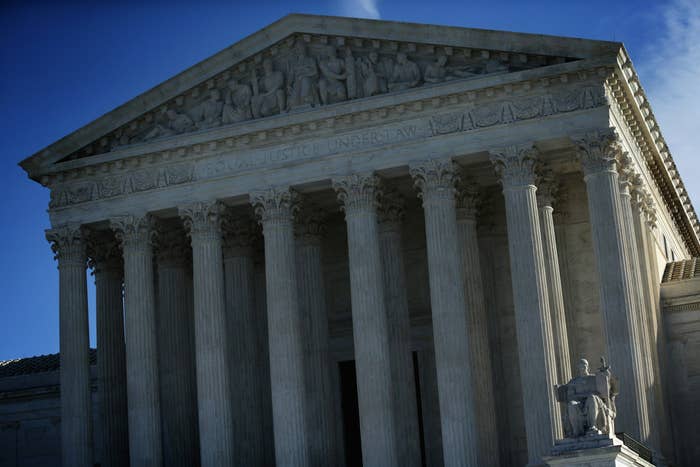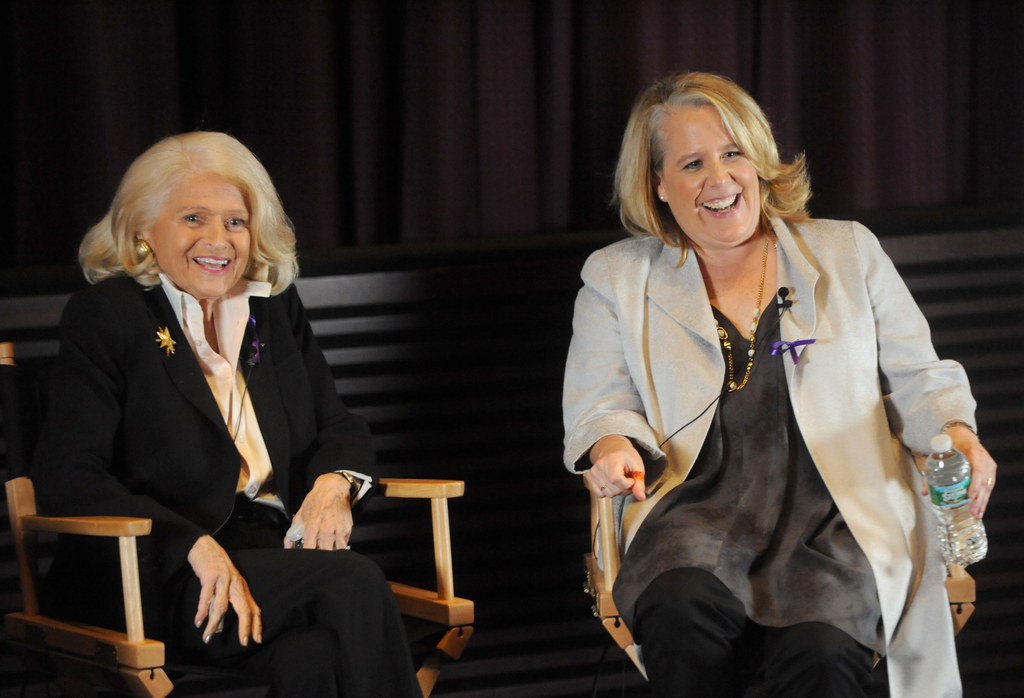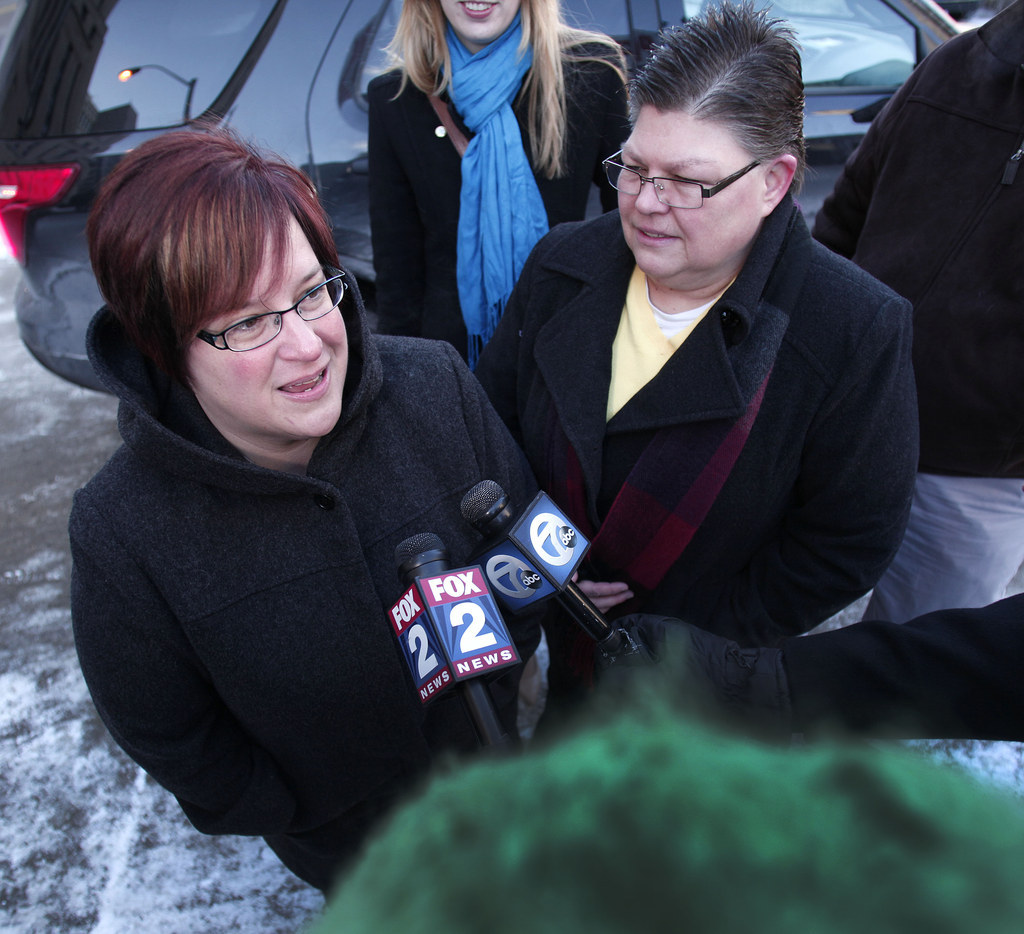
On Friday, the Supreme Court justices will be meeting to decide whether to hear a case — or multiple cases — challenging a ban on same-sex couples' marriages.
This will be the second time the justices have considered whether to take any of the cases out of Kentucky, Michigan, Ohio, and/or Tennessee. When they did so on Jan. 9, they took no action on those cases, instead re-listing them for discussion on Friday.
This is a new practice by the court over the past year or so, re-listing cases they are considering taking once before accepting a case, called granting a writ of certiorari.
The justices did, however, deny an attempt by same-sex couples in Louisiana to have the Supreme Court hear their case before the appeals court — which heard their appeal on Jan. 9 — decided on the appeal.
Now, however, they are faced with choosing whether they will hear one or more of the four other cases — a decision that will foretell whether the justices intend to resolve the question of bans on marriage for same-sex couples nationwide by this June.
How did the justices get here?
In 2013, the Supreme Court declared the Defense of Marriage Act's ban on recognizing same-sex couples' marriages to be unconstitutional. The court also dismissed an appeal of a challenge to California's Proposition 8 marriage ban on a technicality.
In striking down DOMA's ban on federal recognition of same-sex couples' marriages in Edith Windsor's case on June 26, 2013, however, the justices opened the floodgates for marriage equality.
Just short of six months later, on Dec. 20, 2013, a federal judge in Utah declared the state's ban unconstitutional. U.S. District Court Judge Robert Shelby refused to put his ruling on hold during the appeal, same-sex couples began marrying, and 2014 began with 18 states that allowed same-sex couples to marry. The Supreme Court eventually stepped in on Jan. 7, 2014, to stop marriages from proceeding while the case was appealed.
A year later, more than double as many states had marriage equality, with same-sex couples marrying in all of 35 states and in parts of two more.

Marriage, marriage, everywhere.
The remarkable pace was the result of an unprecedented number of nearly unanimous opinions striking down state bans from Alaska to Wyoming to Florida and almost everywhere in between. For a time, in fact, it was only the one district court judge in Louisiana who upheld a state's ban.
Several federal appeals courts began to weigh in over the summer of 2014, with Utah and Oklahoma's bans being struck down by the 10th Circuit Court of Appeals and then Virginia's ban being struck down by the 4th Circuit Court of Appeals. The 7th Circuit Court of Appeals followed, striking down Indiana and Wisconsin's bans.
The rulings in those states were on hold, though, until the Supreme Court announced on Oct. 6, 2014, that it would not be accepting any of the states' appeals. The appeals court rulings would stand, and the bans had come to an end in those five states. Marriage equality spread to other states within those circuits, and the 9th Circuit Court of Appeals announced that it, too, was striking down bans — now in Idaho and Nevada.
Nevada officials were done fighting, but Idaho officials wanted to appeal the issue further. They asked the Supreme Court to keep the ruling on hold — as the justices had done with the first batch of cases. Now, though, things were different. The Supreme Court, after a short delay, denied Idaho's request — giving no reasoning for their decision but sending ripples throughout the country.
More judges struck down more bans.
Then, on Nov. 6, the 6th Circuit Court of Appeals broke the streak, upholding the bans in Kentucky, Michigan, Ohio, and Tennessee.
Judge Jeffrey Sutton, joined by Judge Deborah Cook, reversed the district court decisions in all four states — setting up the Supreme Court showdown that is likely to be announced on Friday.
Earlier in the year, Justice Ruth Bader Ginsburg had told people to keep an eye on the 6th Circuit ruling, noting that there would be more urgency for the Supreme Court to take a case if there was a circuit split — in other words, if the appeals courts disagreed on the issue.
Until the 6th Circuit ruling, the appeals courts were in agreement; after, a circuit split was created. In the weeks that followed, the plaintiffs in the various cases asked the Supreme Court to grant certiorari and hear their appeals.

What are the justices going to do?
The first rule of the Supreme Court is that there are, basically, no rules for the Supreme Court. The court can reverse prior decisions, and the court's policies and practices can change if the justices so desire it. As a result of this, it's difficult to know what the justices are going to do at any given moment.
With that giant caveat, the justices most likely are going to decide on Friday to take one or more cases for review this term — which would mean a decision would be expected by the end of June.
The pace and pure number of all of the cases making their way up the chain have, effectively, forced the justices' hands on the matter. Even if they had hoped in 2013, by dismissing the California Prop 8 challenge, to put off the issue for another four or five years, the issue came back to them far more quickly than that. Even if they had hoped this past October, by denying certiorari in cases where the bans had been struck down, to put off the issue until next term, the 6th Circuit decision came quickly enough to bring the issue up to the justices a second time this term.
This time, there is no good way for the justices to dodge the issue. And, while the justices could keep re-listing the cases until it forces them into the next term, such a move seems unlikely given the current climate.
Assuming the justices are going to take at least one of the cases, they also must decide which one they will take.
The four cases in which plaintiffs are seeking certiorari are not the same.
In Michigan, a full trial was undertaken in response to April DeBoer and Jayne Rowse's challenge, who are seeking to be married in Michigan. This case is, in simpler terms, a marriage case.
In Ohio and Tennessee, on the other hand, the plaintiffs are seeking recognition of same-sex couples' marriages granted by other states. In Ohio, James Obergefell is seeking recognition of his marriage to John Arthur on Arthur's death certificate. Other plaintiffs in Ohio, including Brittni Rogers and Brittani Henry, are seeking recognition of their marriage on their children's birth certificates and for other purposes. In Tennessee, plaintiffs, including Valeria Tanco and Sophy Jesty, are seeking recognition of their marriages for a wide variety of purposes. The Tennessee plaintiffs also challenge whether Tennessee's recognition ban violates their right to interstate travel.
In Kentucky, meanwhile, some plaintiffs, including Timothy Love and Lawrence Ysunza, challenge the state's marriage ban while other plaintiffs, including Gregory Bourke and Michael Deleon, challenge the marriage recognition ban.
If the justices are looking to the lawyers to help them decide which case to take — an issue examined at length in a recent blockbuster Reuters report — then the Kentucky plaintiffs' addition of Stanford Law School's Jeffrey Fisher to their legal team and the Tennessee plaintiffs' help from Ropes & Gray's Douglas Hallward-Driemeier could be a bonus for their teams.
On the other hand, there are national LGBT advocacy group lawyers on all four cases, in addition to local counsel, many of whom have significant experience with LGBT legal issues: Gay & Lesbian Advocates & Defenders' Mary Bonauto is helping with the Michigan plaintiffs; Lambda Legal and the ACLU are assisting with the Ohio plaintiffs; National Center for Lesbian Rights lawyers are on the Tennessee plaintiffs' case; and the ACLU is also helping with the Kentucky plaintiffs.
If the justices want the simplest case, with the most detailed record, in order to resolve the issue, the Michigan marriage case would be the case to take. If the justices want a single legal team that would present clear facts about both marriage and marriage recognition claims, then Kentucky is the way to go. Finally, the justices could take some combination of the four cases, either consolidating the cases to be heard as one, letting the lawyers figure out how argument time will be split, or hearing cases in succession.
In any event, after Friday's conference, if a decision is made to take one or more cases, the decision is expected to be announced that afternoon.
There is a slight — but unlikely — possibility that the court could wait until Tuesday, Jan. 20, to announce whether it will be hearing a case, but that is unlikely. Usually, at this point in the court's term, such an announcement would be expected Friday afternoon.
Then, if a case is accepted, the timeline starts for the filing of briefs by both sides and by outside parties, and arguments would be set — likely in April.
Finally, a decision would be expected before the court adjourns for its summer recess — usually by late June.
This post has been updated to clarify the Supreme Court's dismissal of California's Proposition 8 appeal.
